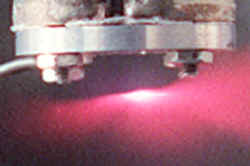A Short Bunch of Neutrons

If researchers ever build a commercial fusion reactor for generating electric power, its inner walls will need to withstand tremendous abuse. According to some estimates, every atom of the surface surrounding the fusion region would be jostled 100 times by high energy neutrons over several years of operation, posing huge challenges for materials scientists. A team reporting in the 23 October PRL has developed a way to produce extremely short (sub-nanosecond) bursts of fast neutrons, which–after improvements–may be used to study the atomic-scale details of the wall-damaging process, as an early step in developing better materials. Since current neutron pulses are rarely shorter than a microsecond, the system could also be used for other time resolved neutron experiments, which are not possible today.
The materials problem is one of the major technological challenges for development of practical fusion energy, says Todd Ditmire of the Lawrence Livermore National Laboratory in California. “Any standard material just turns to cottage cheese” under the conditions in a fusion reactor, he says. So researchers have used large scale computer simulations to learn about the neutrons’ destruction at the atomic scale. The work suggests that a single neutron zipping through a crystal can melt 105 ions, which re-crystallize–although imperfectly–within a nanosecond. The accumulating imperfections gradually destroy the material. But this picture is difficult to verify with current neutron sources such as accelerators and fission reactors.
Ditmire and his colleagues found last year that if they blast a cluster of a few thousand deuterium (heavy hydrogen) atoms with a 35 fs, 150 mJ laser pulse, the electrons abandon the cluster, leaving the ions to explode violently from their mutual repulsion. The explosions are so violent that deuterons from neighboring clusters within the laser’s focal region fuse and emit neutrons. Now they have characterized the neutron pulse in detail, showing that it’s only 650 ps wide when it arrives 9 cm from the fusion region and has a relatively narrow spectrum of neutron energies, all near the 2.45 MeV expected for a neutron from fusion. Their calculations suggest that 100 ps neutron pulses are possible.
After increasing the neutron flux, Ditmire hopes within a few years to use this tabletop system to take unprecedented data documenting the fundamental physics of radiation damage. A solid sample would be hit first by the neutron pulse and then, following a variable delay, with an ultrashort x-ray pulse from the same laser, which would give information on structural changes in the sample. “You could make a movie of this melting and recrystallization” predicted by the simulations, Ditmire says. And the results ought to apply to the development of other radiation protection materials, such as those used to store nuclear waste and to contain neutrons in fission reactors.
Donald Umstadter of the University of Michigan in Ann Arbor agrees that the new lab-sized system for producing neutron pulses will be much easier and more accessible than other neutron sources and could be important for the fusion community. “Just being able to produce neutrons with such a small laser is an exciting development,” he notes. Since time-resolved studies with neutrons have not been possible in the past, team member Jason Zweiback says more applications could come up. “Once you show someone you have a viable source, a lot of poeple come up with ideas of what to do with it.”


